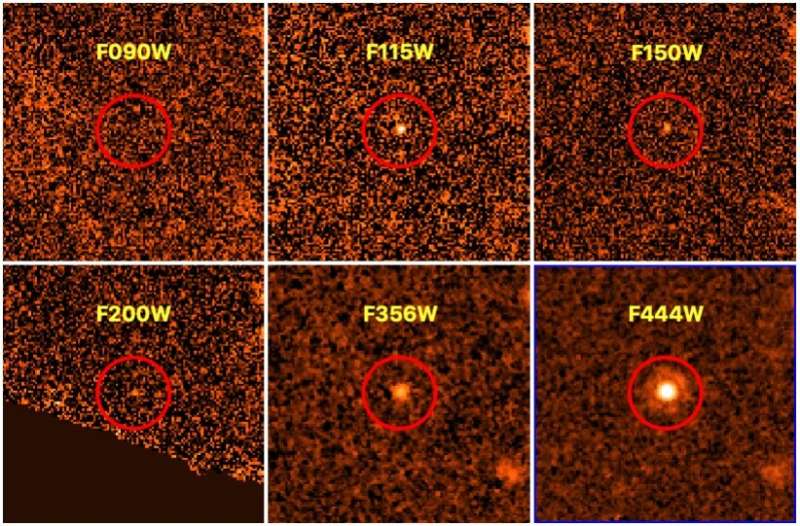Image cutouts of GLASS-JWST-BD1. Credit: Nonino et al., 2022.
Using the James Webb Space Telescope (JWST), an international team of astronomers have detected a new faint, distant, and cold brown dwarf. The newly found object, designated GLASS-JWST-BD1, turns out to be about 31 times more massive than Jupiter. The discovery was detailed in a paper published July 29 on arXiv.org.
Brown dwarfs are intermediate objects between planets and stars. Astronomers generally agree that they are substellar objects occupying the mass range between 13 and 80 Jupiter masses. One subclass of brown dwarfs (with effective temperatures between 500 and 1,500 K) is known as T dwarfs, and represents the coolest and least luminous substellar objects so far detected.
Studies of T dwarfs could help astronomers better understand objects near the disputed planet/star boundary, for instance, giant exoplanets. However, although many brown dwarf have been detected to date, T dwarfs are not so common, as only about 400 such objects have been identified.
Now, a group of astronomers led by Mario Nonino of the Astronomical Observatory of Trieste in Italy, reports the finding of a new brown dwarf that is most likely of T dwarf subclass. The discovery was made as part of the Through the Looking GLASS (GLASS-JWST) project—a JWST Early Release Science (ERS) program targeting the massive galaxy cluster Abell 2744 with JWST's Near-Infrared Spectrograph (NIRSPEC) and Near-Infrared Imager and Slitless Spectrograph (NIRISS).
"We present the serendipitous discovery of a late T-type brown dwarf candidate in JWST NIRCam observations of the Early Release Science Abell 2744 parallel field. The discovery was enabled by the sensitivity of JWST at 4 µm wavelengths and the panchromatic 0.9–4.5 µm coverage of the spectral energy distribution," the researchers wrote in the paper.
According to the study, GLASS-JWST-BD1 has a mass of about 31.43 Jupiter masses and an effective temperature of some 600 K. The age of this brown dwarf was estimated to be 5 billion years.
Comparison with theoretical models suggest that GLASS-JWST-BD1 is a late-type T dwarf. Its distance was measured to be between 1,850 and 2,350 light years, in a direction perpendicular to the Galactic plane. The results indicate that this object is likely a member of the Galactic thick disk or halo population.
The astronomers noted that further observations of GLASS-JWST-BD1 are required in order to confirm its T-dwarf nature. In particular, kinematic or chemical abundance data are needed to get more insights into the properties of this object.
In concluding remarks, the authors of the paper underlined how their discovery demonstrates the capability of JWST to investigate distant low-mass Galactic stellar and substellar objects.
"The large estimated distance of GLASS-JWST-BD1 confirms the power of JWST to probe the very low-mass end of the stellar and substellar mass function in the Galactic thick disk and halo, enabling exploration of metallicity dependence on low-mass star formation and the evolution of brown dwarf atmospheres," the scientists wrote.
More information: M. Nonino et al, Early results from GLASS-JWST. XIII. A faint, distant, and cold brown dwarf. arXiv:2207.14802v1 [astro-ph.SR], arxiv.org/abs/2207.14802
© 2022 Science X Network
























